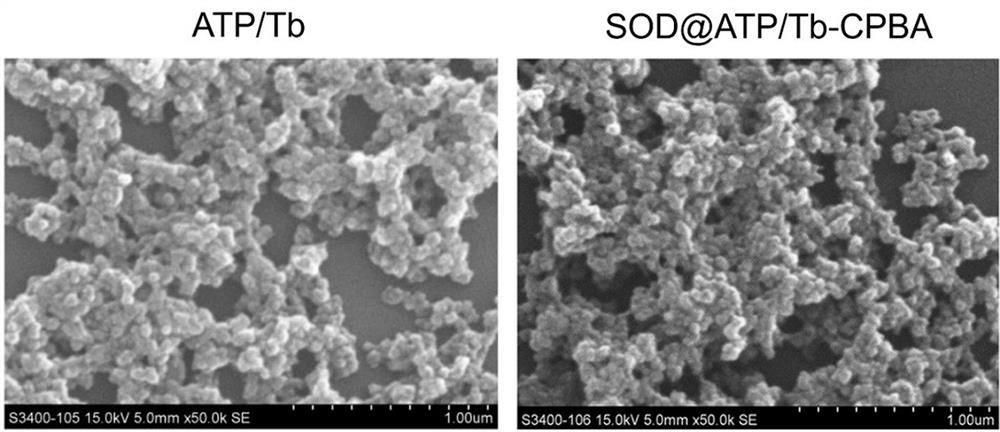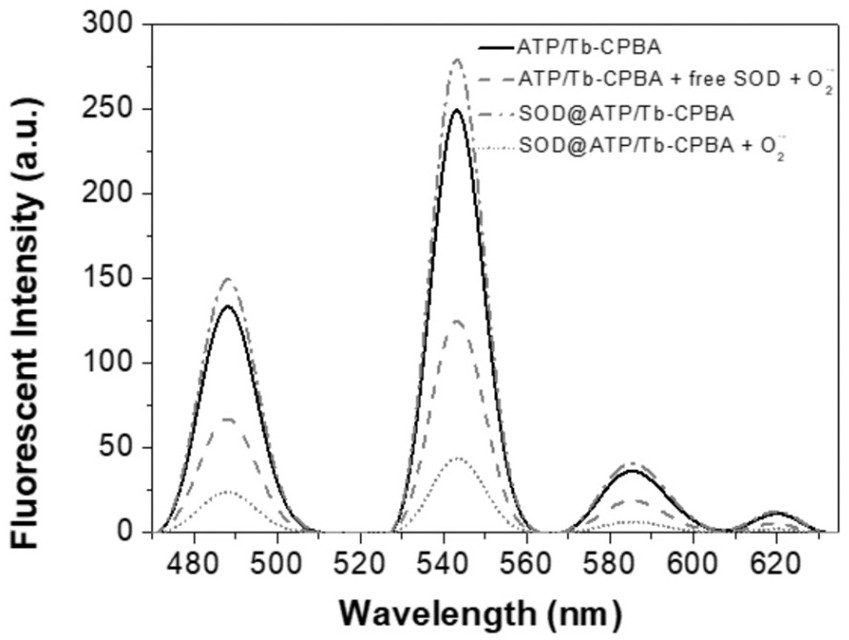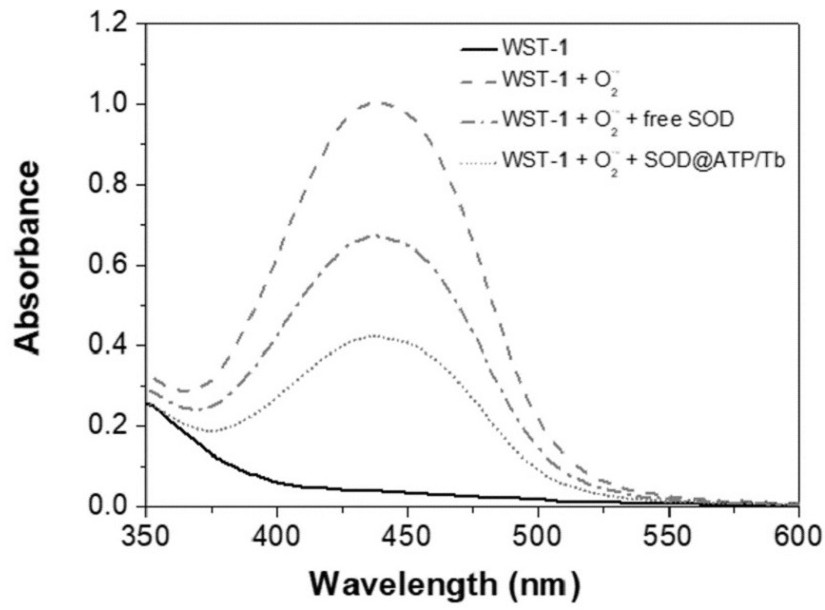Preparation method and application of enzyme-integrated rare earth coordination polymer
A technology of coordination polymers and rare earths, which is applied in the preparation and application of fluorescent probes, can solve the problems of nano-probes in their infancy, improve detection sensitivity and selectivity, improve catalytic activity and stability, and eliminate interference Effect
- Summary
- Abstract
- Description
- Claims
- Application Information
AI Technical Summary
Problems solved by technology
Method used
Image
Examples
preparation example Construction
[0027] A method for preparing an enzyme-integrated rare-earth coordination polymer, combining an enzyme with a rare-earth coordination polymer with fluorescent properties, specifically comprising the following steps:
[0028] (1) Metal salt terbium nitrate (Tb(NO 3 ) 3 ) aqueous solution and 20 μg / mL~25 μg / mL superoxide dismutase (SOD) are pre-stirred for 30 minutes;
[0029] (2) Add an aqueous solution of the ligand adenosine triphosphate (ATP), react for 3 hours, centrifuge at 13,000 rpm for 10 minutes, and separate to obtain a solid product, wherein the metal salt terbium nitrate (Tb(NO 3 ) 3 ) and the molar ratio of ligand adenosine triphosphate (ATP) is 8:3;
[0030] (3) Wash the solid product separated in step (2) with water for 3 times, then mix and react with the antenna molecule carboxyphenylboronic acid (CPBA) for 12 hours, and then separate the final solid product, which is the enzyme-integrated rare earth Coordination polymers.
Embodiment 1
[0033] Follow the steps below to prepare SOD@ATP / Tb-CPBA:
[0034] (1) 5.5mg of terbium nitrate was dissolved in 4mL water to obtain an aqueous solution of terbium nitrate;
[0035] (2) 0.1mg SOD was dissolved in 0.1mL water to obtain SOD aqueous solution;
[0036] (3) 6.1 mg of ATP was dissolved in 4 mL of water to obtain an aqueous ATP solution;
[0037] (4) After mixing 4 mL of terbium nitrate aqueous solution and 0.1 mL of SOD aqueous solution, stir for 30 min; then add ATP aqueous solution, and continue stirring for 3 h; wash with water for 3 times to obtain SOD@ATP / Tb;
[0038] (5) 13.3mg CPBA was dissolved in 0.4mL water to obtain CPBA aqueous solution;
[0039] (6) Take the 3.6mL SOD@ATP / Tb (0.1mg / mL) aqueous solution prepared in the above step (4) and step (5) and mix it with 0.4mL CPBA aqueous solution, stir for 12h and centrifuge (13000rpm, 10min), and Washed 3 times with water to obtain SOD@ATP / Tb-CPBA.
Embodiment 2
[0041] Combined with water-soluble tetrazolium salt reagent (WST-1) to detect superoxide anion, and record the absorbance corresponding to its maximum absorption peak with a UV spectrophotometer to detect the catalytic activity of superoxide anion of SOD. Its method steps are:
[0042] (1) 4-Hydroxyethylpiperazineethanesulfonic acid (HEPES) with pH = 7.4 was used as a buffer solution with a total volume of 200 μL and a reaction temperature of 37° C.;
[0043] (2) The superoxide anion is formed by KO dissolved in dimethyl sulfoxide (DMSO) solution 2 get;
[0044] (3) Use a 96-well plate, and number the reaction wells as a, b, c, and d respectively; where,
[0045]The preparation method of the solution in the reaction well a is: HEPBS buffer solution with pH=7.4 containing 10 μM WST-1 reagent, react in a water bath at 37°C for 20 minutes;
[0046] The preparation method of the solution in reaction well b is: HEPBS buffer solution with pH=7.4 containing 10 μM WST-1 reagent and...
PUM
 Login to View More
Login to View More Abstract
Description
Claims
Application Information
 Login to View More
Login to View More - Generate Ideas
- Intellectual Property
- Life Sciences
- Materials
- Tech Scout
- Unparalleled Data Quality
- Higher Quality Content
- 60% Fewer Hallucinations
Browse by: Latest US Patents, China's latest patents, Technical Efficacy Thesaurus, Application Domain, Technology Topic, Popular Technical Reports.
© 2025 PatSnap. All rights reserved.Legal|Privacy policy|Modern Slavery Act Transparency Statement|Sitemap|About US| Contact US: help@patsnap.com



